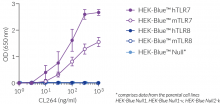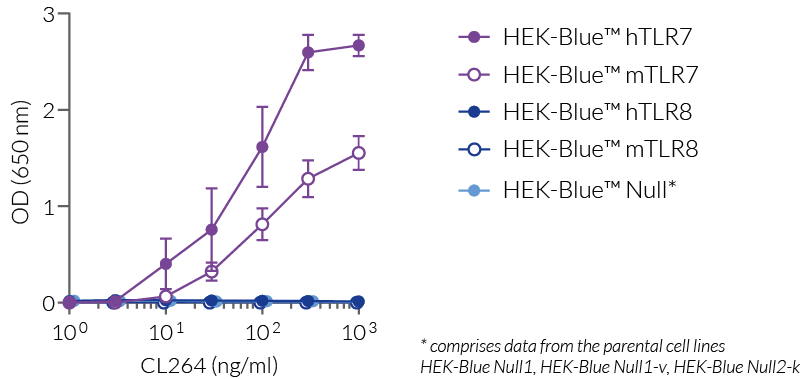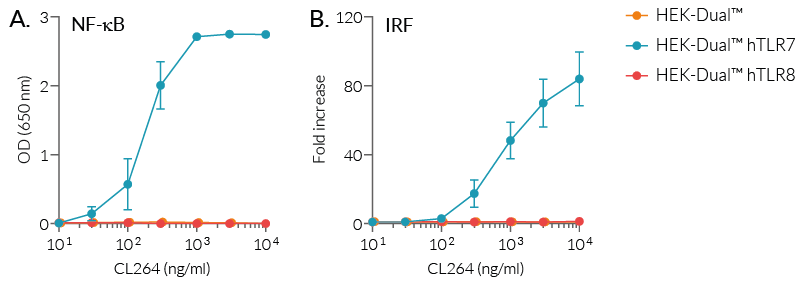CL264
| Product | Unit size | Cat. code | Docs. | Qty. | Price | |
|---|---|---|---|---|---|---|
|
CL264 Adenine analog |
Show product |
5 mg |
tlrl-c264e-5
|
|
TLR7 Agonist - Adenine analog
 InvivoGen also offers:
InvivoGen also offers:
• TLR reporter cells: HEK293, RAW, THP-1 cells
• TLR research tools: Antibodies, Inhibitors, etc.
CL264 is a 9-benzyl-8 hydroxyadenine derivative containing a glycine on the benzyl group (in para). CL264 is a strong Toll-like receptor 7 (TLR7) agonist. It does not stimulate TLR8. TLR7 and TLR8 are endosomal pattern recognition receptors that play an important role in the antiviral immune response [1].
Mode of action
Similarly to CL-087 (SM360320), CL264 induces the activation of NF-κB and the secretion of IFN-α in TLR7-expressing cells [2].
Using our HEK-Blue™ reporter cell lines expressing human or mouse TLR7 or TLR8, we established that CL264 is a human and mouse TLR7-specific agonist. It does not stimulate human or murine TLR8, even at high concentrations (> 10 µg/ml) (see figure). Moreover, CL264 is able to activate the TLR7-dependent NF-κB and IRF pathways, as assessed using InvivoGen's HEK-Dual™ reporter cell lines expressing two reporter genes for the NF-κB-inducible SEAP and IRF-inducible Lucia luciferase, as well as human TLR7 or TLR8 (see figure). CL264 triggers NF-κB activation at a concentration of 10 ng/ml which is ~30 times less than imiquimod.
Key features of CL264
- Specific agonist of human and mouse TLR7
- Higher potency towards human TLR7
- Does not activate human or mouse TLR8
- Each lot of CL264 is highly pure (≥95%) and functionally tested
References:
1. Schön M.P. & Schön M., 2008. TLR7 and TLR8 as targets in cancer therapy. Oncogene. 27:190-199.
2. Lee J. et al., 2006. Activation of anti-hepatitis C virus responses via Toll-like receptor 7. PNAS 103(6):1828-33.
Specifications
Specificity: human/mouse TLR7 agonist
Working concentration: 50 ng- 10 µg/ml
Solubility: 1 mg/ml in water
Formula: C19H23N7O4
Molecular weight: 413.43 g/mol
Quality control:
- Purity: ≥95% (UHPLC)
- The biological activity of CL264 has been validated using cellular assays.
- The absence of bacterial contamination (e.g. lipoproteins and endotoxins) has been confirmed using HEK-Blue™ hTLR2 and HEK-Blue™ hTLR4 cells.
Contents
- 5 mg CL264
- 10 ml of sterile endotoxin-free water
![]() CL264 is shipped at room temperature.
CL264 is shipped at room temperature.
![]() Upon receipt, store at -20°C.
Upon receipt, store at -20°C.
Back to the top
Details
TLR7 and TLR8
TLR7 and TLR8 are endosomal pattern recognition receptors that share structural homology [1]. Both receptors are activated by single-stranded RNA (ssRNA) molecules, however, they exhibit different ligand-binding specificities and cellular expression patterns suggesting that they have nonredundant specialized roles.
TLR7 is essentially expressed by plasmacytoid dendritic cells (pDCs) but is also found in B cells and other myeloid cells [2] while TLR8 is highly expressed by myeloid cells and is absent from pDCs and B cells [2].
The endosomal distribution of TLR7 and TLR8 allows them to scan for the presence of microbial RNA in the phagocytic cargo. Their activation leads to NF-κB-, AP1-, and interferon regulatory factor (IRF)-mediated production of type I interferons (IFN-α/β) and pro-inflammatory cytokines [2].
Structural analyses have revealed that both TLR7 and TLR8 possess two binding sites (designated as Site 1 and Site 2) which do not share the same specificities.
Site 1 is highly conserved between TLR7 and TLR8 and binds nucleosides (guanosine (G) for TLR7 and uridine (U) for TLR8) or base analogs. The ligand preference for TLR7 and TLR8 is thus explained by the presence of specific residues in Site 1. Site 1 occupancy allows receptor dimerization and signaling.
Site 2 is less conserved and binds ssRNA with U(U) and U(G) motifs, respectively [3, 4]. Of note, ssRNA-binding to Site 2 is not sufficient for the formation of a signaling-competent TLR dimer but it strongly enhances the binding affinity of Site 1 [3, 4]. Thus, TLR7 and TLR8 appear to sense distinct RNA-degradation products rather than full-length ssRNAs [4].
1. Chuang T.H. & Ulevitch R.J., 2000. Cloning and characterization of a sub-family of human toll-like receptors: hTLR7, hTLR8, and hTLR9. Eur Cytokine Netw, 11:372-8.
2. Georg P. & Sander L.E., 2019. Innate sensors that regulate vaccine responses. Curr. Op. Immunol. 59:31.
3. Zhang Z. et al., 2018. Structural analyses of Toll-like receptor 7 reveal detailed RNA sequence specificity and recognition mechanism of agonistic ligands. Cell Rep. 25:3371.
4. Tanji H. et al., 2015. Toll-like receptor 8 senses degradation products of single-stranded RNA. Nat. Struct. Mol. Biol. 22:109.
Chemical structure of CL264:









